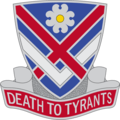183rd Cavalry Regiment (United States)
The 183rd Cavalry Regiment is a cavalry regiment of the United States Army, Virginia Army National Guard. The 183rd Cavalry was established as the 183rd Infantry Regiment and was reflagged as a cavalry regiment in 2006. The 2nd Squadron, 2-183, is a maneuver element in the 116th Infantry Brigade Combat Team. Headquarters and Headquarters Troop, 2nd Battalion, 183rd Cavalry is one of several Army National Guard units with campaign credit for the War of 1812.
| 183rd Cavalry Regiment | |
|---|---|
 Coat of arms | |
| Country | United States |
| Allegiance | Virginia |
| Branch | United States Army National Guard |
| Role | RSTA |
| Size | Squadron |
| Motto(s) | Death to Tyrants |
| Colors | Blue, red, and gray. |
| Insignia | |
| Distinctive unit insignia |  |
U.S. Cavalry Regiments | |
|---|---|
| Previous | Next |
| 180th Cavalry Regiment | 202nd Cavalry Regiment |
U.S. Infantry Regiments | |
|---|---|
| Previous | Next |
| 182nd Infantry Regiment | 184th Infantry Regiment |
History
The 183d Infantry Regiment was activated in 1920 following the end of World War I.[1] It was a part of the 91st Infantry Brigade in the Virginia National Guard alongside the 116th Infantry Regiment. The 183d was redesignated the 1st Virginia Infantry, but soon reverted to its old name in 1922, and became a part of the 29th Infantry Division. The regiment participated in training maneuvers with the Virginia Guard until the United States became involved in World War II. The 183d was broken up and provided men to various other units. After the war, in 1959, the 1st Battalion, 183d Infantry was reactivated as the 1st Squadron, 183d Armor, and served as the 29th Infantry Division's reconnaissance squadron until later inactivation.[1]
The Infantry/Armor unit was reactivated as the 2d Squadron, 183d Cavalry Regiment on 11 February 2006. It was assigned to the 116th Infantry Brigade Combat Team of the 29th Infantry Division.[2] The new squadron was given the mission of providing reconnaissance, surveillance, and target acquisition (or RSTA) for the brigade, and acted as the "eyes and ears" of brigade's commander. From September 2007 to May 2008, the squadron conducted security operations in Kuwait and Southern Iraq in support of Operation Iraqi Freedom.[3] In August 2011, the 2-183d Cavalry deployed to Iraq again where it conducted convoy security operations under the name of Task Force 183. With 825 members, this was the largest deployment of Virginia National Guard soldiers since World War II.[3] The unit returned home in December 2011.[4]
The 183d Infantry Regiment also became the 183d Regiment during the reorganization, and facilitates the Virginia Army National Guard's RTI (Regional Training Institute) at Fort Pickett, Virginia. Colonel James A. Zollar became commander of the RTI in June 2016.[5]
Current Structure
2nd Squadron, 183rd Cavalry Regiment[6]
- Headquarters and Headquarters Troop; Portsmouth
- A Troop; Virginia Beach, Virginia
- B Troop; Suffolk
- C Troop; Virginia Beach
- D Company, 429th Brigade Support Battalion; Franklin
- Detachment 1; Franklin
183rd Regiment (Regional Training Institute)[5]
- 1st Battalion; Fort Pickett
- 2nd Battalion; Fort Pickett
- 3rd Battalion; Fort Pickett
References
- http://ead.lib.virginia.edu/vivaxtf/view?docId=lva/vi00860.xml
- Pike, John. "2nd Squadron, 183rd Cavalry Regiment". GlobalSecurity.org. Retrieved 9 July 2016.
- Puryear, Cotton (15 December 2011). "Last group of Va. Guard Soldiers from Task Force 183 return to United States after duty in Iraq". Virginia National Guard. Archived from the original on 26 October 2016. Retrieved 9 July 2016.
- Zane, Anthony (5 December 2011). "Guard's last convoy puts Iraq in rearview mirror". United States Army. Retrieved 9 July 2016.
- Puryear, Cotton (27 June 2016). "Zollar takes command of 183rd RTI". Virginia National Guard. Retrieved 9 July 2016.
- "2nd Squadron, 183rd Cavalry Regiment". CurrentOps.com. Retrieved 9 July 2016.